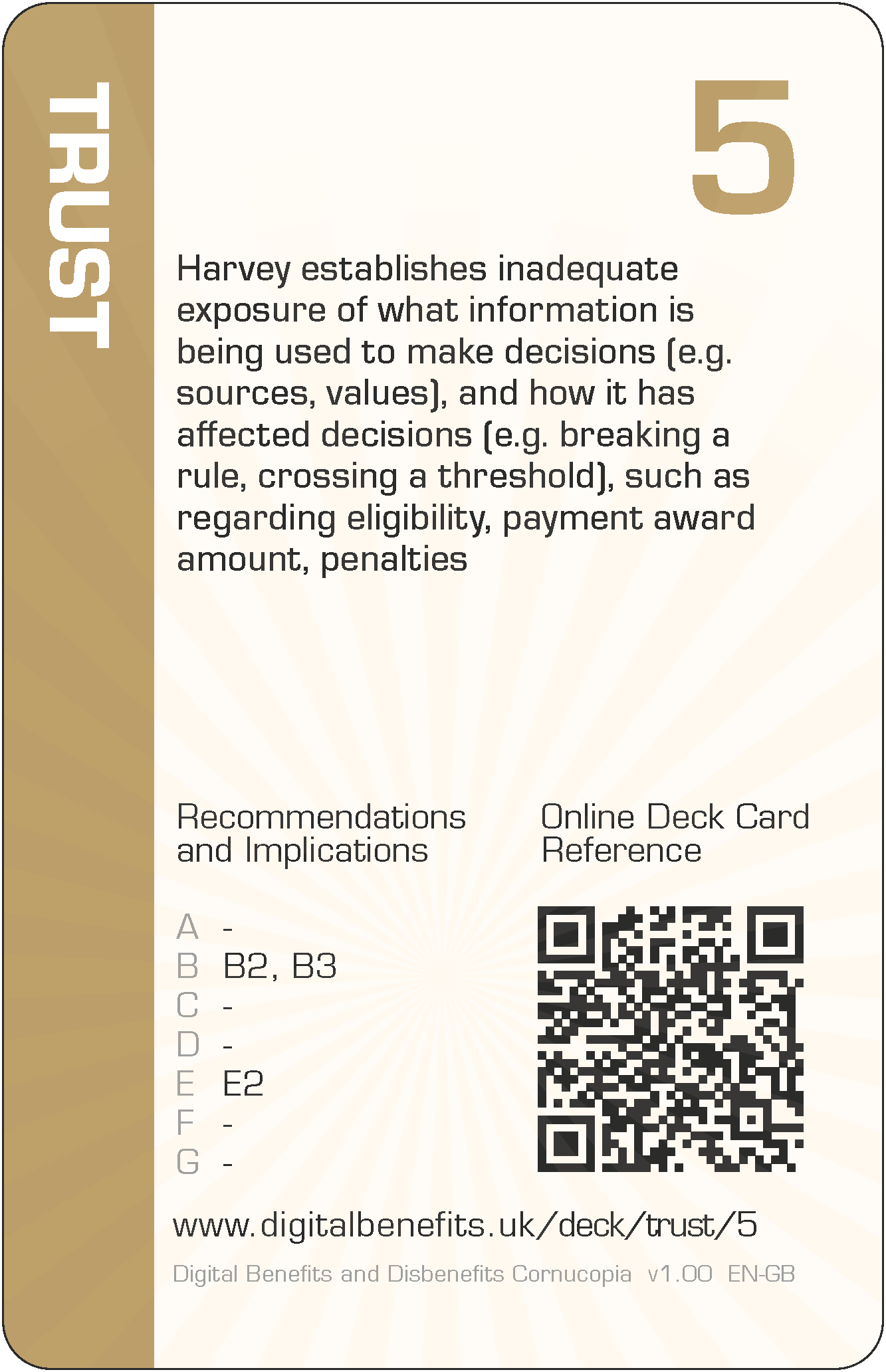Trust 5 (TR-5) Card
DBD Cornucopia > Deck > Trust > 5
Card Details - Five of Trust
Abbreviation
TR-5
Card's focus
The focus of this card is data sources, uses and calculations/algorithms/rules
Threat to claimants
Harvey establishes inadequate exposure of what information is being used to make decisions (e.g. sources, values), and how it has affected decisions (e.g. breaking a rule, crossing a threshold), such as regarding eligibility, payment award amount, penalties

Threat to claimants
Harvey establishes inadequate exposure of what information is being used to make decisions (e.g. sources, values), and how it has affected decisions (e.g. breaking a rule, crossing a threshold), such as regarding eligibility, payment award amount, penalties.
Some examples of how this threat could lead to harms (negative effects on claimants)
The design recommendations and implications relevant to the card are listed below in the next section, but even those can be somewhat abstract and difficult to think about during practical day-to-day implementation. Therefore, some example harms are provided to complement the more formal research outputs. These examples are unique per card, and are only published on these web pages (i.e. in no other project outputs).
- Knowledgeable welfare benefit advisors cannot make sense of claim decisions due to a lack of information about what they have been based on, limiting the advisors' ability to check the decisions, and help claimants further
- Claimants are unaware their award has been calculated using old, and now inaccurate, information, which has reduced their award or ended their claim
- Claimants feel unfairly treated because sanctions imposed seem incorrect, and the information used and justification are not explained
- Digital automated decision making embeds assumptions that some more marginalised groups are more likely to commit fraud or are undeserving of receiving welfare benefit awards, leading to claimants being unfairly discriminated against
- Claimants are not informed when accusations of fraud arise from an algorithm, affecting their ability to challenge decisions and provide counter evidence
- Insufficient auditing around use of algorithms and their outputs and impacts, causes claimants to be disadvantaged for too long before the system's problems are detected and corrected, and remedied
- Profiling creates derived, inferred and predicted profiles of claimants which are inaccurate leading to them being misidentified, misclassified or misjudged which cause problems with their claims, and some to self-harm as a result
The examples are to help understand the threat on the card, not to suppress thinking and innovation. Incorporating these examples exactly, or closely matching ones, should be scored down when playing DBD Cornucopia as a game.
Applicable design recommendations and implications
These are reproduced here from Research Briefing N
Acknowledge claimants as people in digital design
- Ensure system and state accountability to claimants
Equalise accountability between claimants and the state. Promote a sense of fairness by enforcing an expectation that service level standards for actions and response times should be similar to those expected of claimants, with related penalties not disproportionately, or only, affecting claimants. Provide tools/methods for claimants to easily check, query and challenge actions and decisions. - Provide clear and configurable communications about process and decision statuses
Use methods proactively, such as internal notifications and external alerts, to help people understand what they need to do/when, and what is in progress by others. Provide confirmations when actions have been completed, information received, decisions made and statuses changed. To accommodate people's individual needs and preferences, provide choices about what, when and how these are re- ceived, who they are sent to and copied to. Offer content options such as whether to have a topic, priority and hyperlink, and ensure it is clear where and how to complete any required action.
Design systems which support the division of labour with claimants' ecosystems
- Expand claimant autonomy, control and choice, backed up by transparency of actions and activities
Enable claimants to better engage with digital welfare and empower them to make their own choices and decisions. Attribute information sources, other advice and decisions; build in logging and audit trail generation; provide access to records of what information was used to make choices/decisions and by whom; provide mechanisms for claimants to question, discuss and challenge actions, provide feedback, and make complaints.
General Notes
Card values (i.e. '5' for this card) are for game play and are not correlated with the severity of harm. This is because threats cannot be ranked directly since they can affect individuals in different ways due to situations and circumstances, or affect fewer or more claimants, or the harms can arise in claimants' support networks and wider society.
The threat description uses a person's name as the "attacker" (i.e. 'Harvey' for this card), which can be thought of someone involved with implementation. They could have any role which influence digitisation. So they could be a database administrator, or a copy writer, or a quality assurance specialist, etc, or all of these. Everyone could have some influence on the claimant threat described. The names were randomly selected from those currently most popular as given names for boys and girls (UK Office for National Statistics).
The example harms provided are drawn from the research data (which explored not only parts of existing services but also the effects of possible changes to those), from the author's own knowledge of web application development and testing, the author's own experience of helping citizens to claim Universal Credit (UC) and Personal Independence Payment (PIP), and from suggestions submitted by other people (make a suggestion). The threats and example harms do not necessarily exist in the current UC or PIP deployments or in ecosystems around those services, but they might well do.
All the cards in this Trust suit are: 2 3 4 5 6 7 8 9 10 J Q K A
The other suits in the deck are: Scope, Architecture, Agency, Porosity and Cornucopia (plus Jokers).
